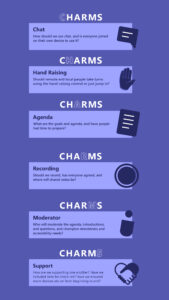By Sean Rintel, Abigail Sellen and Advait Sarkar (Microsoft Research Cambridge), Priscilla Wong (University College London), Nancy Baym, Rachel Bergman, Sharon Gillett, and Danielle Bragg (Microsoft Research New England)

Remote meetings can be really valuable for togetherness and immediacy among colleagues. However, the COVID-19 pandemic has taught us that the artificiality of videocalls, exacerbated by the increase in meetings, is leading to fatigue. How can you preserve the value while reducing the problems? Our position is that thoughtless collaboration will always be poor collaboration no matter how good or bad the technology is.
This guide to better remote meetings draws principles from the Collaboration and Meetings section of The New Future of Work synthesis report. Page numbers in the report are provided if you want to dig into the findings.
The guide covers three aspects of intentionality.
- Choose and balance asynchronous and synchronous collaboration.
- Be more intentional about behavior throughout the remote meeting lifecycle.
- Reflect on how intentionality has affected your actions as individuals, teams, and organizations.
Choose and balance synchronous and asynchronous collaboration
Instead of just having meetings, choose when meetings or asynchronous modes will suit your organizational goals and communicative needs.
Meetings are fast. For many organizations, meetings have become convenient container in which we hope work gets done because of the façade of easy scheduling and dynamism in the moment. The best meetings, especially when remote, promote interactivity over information sharing.
- Meetings are important for being connected with people, for building relationships, for getting to know each other.
- Meetings can be useful when the subject of discussion is complex or uncertain enough to warrant conversation to avoid potential miscommunication, but only if everyone is prepared.
Asynchronous modes scale from fast to slow.
- Asynchronous modalities overall are more searchable, they give people more time to consider the relevant issues, and may be more time-efficient because composing a message and reading a message take very different amounts of time.
- A team that has a place that everyone is expected to update regularly and is considered the ground truth should be able to reserve meetings for critical decisions and team members who find asynchronous work hard.
- You can reduce the burden of spontaneous meetings by first checking if your answer exists in some documentation and check recipient’s presence and working hours before reaching out.
Asynchronous modes in the Microsoft ecosystem:
- Microsoft Teams channels and chat for quick engagement of variable length and detail, and can upgrade to a meeting.
- OneNote and document collaboration allow more thoughtful long-form explorations, explanations, and planning.
- Yammer suits community building, which is rapid in the moment but with a distinctly longer term objective.
Be more intentional about behavior throughout the remote meeting lifecycle
Be intentional about scheduling meetings
Do you need a meeting?
- The primary burden is on the meeting organizer to explain the need for the meeting. Needing people’s attention on something should not be conflated with taking the time to meet about it.
- An empty time slot is not simply an open invitation for a meeting. Ask people whether they prefer meetings in a row or time between meetings, and if your meeting is very important, ask if they will need time for preparation or a break before.
- Check everyone’s timezone, including holidays, and share the burden of early/late meetings.
- Don’t double or triple book without asking.
- Provide people with a way to catch up with the content if they can’t attend.
What is this meeting about?
A meeting should have clear goals and an agenda to meet them.
- What is the project goal and how does this meeting fit?
- The meeting agenda should guide:
- Who is invited/attends and in what capacity. It should be clear who is expected to fully engage, who could monitor a meeting, and generally keep attendance as small as possible. As a potential attendee, you should choose the meetings you attend carefully.
- When the meeting is. How much time do people need to prepare? How long should the meeting last? Recurring meetings need more reasons to exist, not less.
- Where the meeting is. If some attendees are remote, consider having everyone join the meeting from their own device instead together in a conference room. This levels the playing field for all attendees. If you intentionally schedule a hybrid meeting, set everyone’s expectations for remote participation.
Be intentional about conduct in meetings
As a meeting owner
 At the beginning of the meeting start with introductions and set expectations (verbally or in the invite/chat). We suggest using the CHARM framework:
At the beginning of the meeting start with introductions and set expectations (verbally or in the invite/chat). We suggest using the CHARM framework:
- Chat: How should we use meeting chat (see more on this below)?
- Hand raising: Should we use hand raising (a feature or even actual hands!) or just jump in?
- Agenda: What are the meeting goals and agenda?
- Recording: Should we record and has everyone agreed?
- Moderator: Who will moderate the agenda, introductions, and questions.
- Support: How are we supporting one another?
At the end of the meeting, ensure follow-up:
- Leave time for summarizing action-items at the end of your meeting.
- When people say things like “we’ll take this offline”, ensure that there is follow-up and if possible, someone from that offline discussion should report back on it somewhere.
As an attendee
Be intentional about your role in the meeting:
- Do you want to participate? Let the organizer know if you just want to ‘follow’ the meeting. There may be a way for you to get updates without attending and they will know whether to solicit your input. You should be able to decline a meeting, but it’s also helpful if you tell people why you’ve said no.
- Ask: why and how am I contributing now? Speak up and encourage others to do so, but have a reason. ‘Air time’ is limited, but parallel chat and shared documents can help make contributions both inclusive and rich.
- Listen: What is everyone saying? Meetings need to be as much about listening as they are about contributing. Take turns to listen. Help others listen, too, by actively seeking clarity.
Taking turns is one of the biggest challenges in all-remote meetings (page 11). Some things you can do to help are:
- Be clear about when you have reached the end of your thought.
- Be deliberate about selecting next speakers. Be on the lookout to include people who have not yet participated.
- Wait longer for responses than you would for an all in-person meeting.
- Share re-starts. If you re-started last time, let someone else re-start this time. If it keeps happening, pause the meeting and actively establish a way to deal with it.
As a moderator
To help meetings achieve their goals, active moderators should:
- Be energetic, to encourage meeting attendees to be engaged.
- Be up front on how the meeting will be run, including expectations for video on/off, audio muting, and other technical issues.
- Use private chat as well as public announcements to improve inclusion.
- Consider asking remote attendees to speak first, as they will have the hardest time getting a word in edgewise to in-room discussions.
- Delegate tasks to other people if they are overloaded.
- Others should help the moderator speak, if they have been caught up helping others.
Intentional use of tools for meetings
Video and visual representations of audio participants
- Showing video should not be a one-size-fits-all requirement (page 12).
- Consider inviting people to turn on video by explaining why it will help. Not everyone may turn on their video, but a proportion will.
- Individuals and teams should decide on and communicate their video preferences. This may be especially important to ensure inclusion of people with diverse abilities.
- In presentation scenarios, don’t leave presenters speaking into a total void of no-video and muted-audio. If not everyone can or should show video, choose a few representative people to turn their video on, to help the presenter ‘read the room’.
- Video has generally been found to make meetings more comfortable, but not necessarily more effective in every situation. It can have great value in certain situations, such as helping the comprehension of non-native speakers.
Parallel chat in meetings
Parallel chat has become much more common in meetings (page 13). It can improve inclusion but can also be distracting. We have a longer guide to parallel chat in meetings for moderators and participants (based on a research paper), but the basics are as follows:
- Encourage parallel chat that allows more voices to be heard and that amplifies the meeting’s main audio/video. For example, links, on-point questions, clarification, solicited contributions including disagreement, requests for follow-up.
- Consider discouraging parallel chat that is likely of interest to only a small subset of attendees, diverges from the main audio/video, or overwhelms the main conversation.
- Parallel chat can benefit from active moderation.
- Always check on accessibility accommodation if parallel chat will be important.
- Use a follow-up communication to share chat items that deserve special attention.
- Ensure that tabled items from chat are followed-up.
Active agendas in working session meetings
An active agenda is a live shared document that all attendees use in parallel with the meeting itself. It is most useful when the meeting itself is a working session.
- Create a shared document, pre-populate it with the agenda, and encourage contributions.
- The value is both a permanent record and richer interaction because it allows threaded/organised responses. While audio requires a single focus, several text conversations can be occurring in parallel in relevant sections of the document.
- It helps if there is a meeting secretary taking notes and surfacing relevant points to the meeting.
Reflect
A culture of intentionality is also a culture of experimentation.
- Writing down a line or two about meetings afterwards will help individuals and teams reflect later.
- We think that meetings are at their most valuable when being together (space) harnesses the immediacy (time) of the presence of people as skilled and emotional beings (sociality) to enable collective reasoning (purpose). Notes about space, time, sociality, and purpose will quickly build into a valuable archive.
- Discuss the results of intentionality at the end of some period you decide (e.g. two weeks, a month, a quarter).
The key to better meetings is to be more intentional throughout the meeting lifecycle and to consider how meetings fit into our larger workflow. When we add technology into the mix, this means being more intentional about how technology shapes our experiences in and around meetings.

